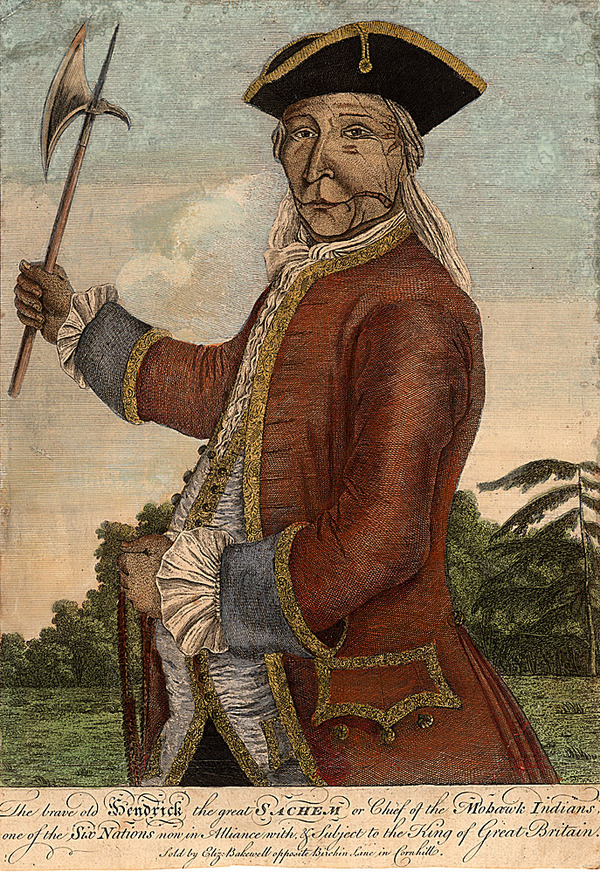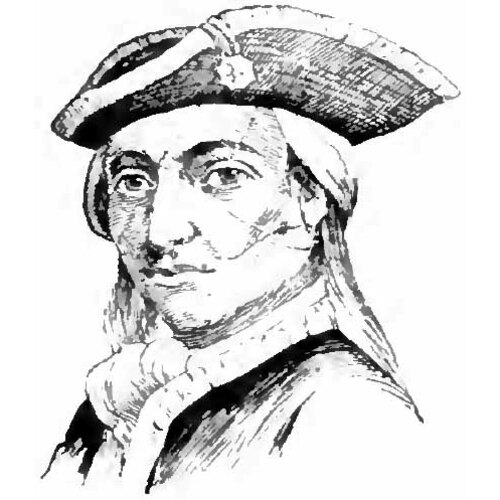
Source: Courtesy of Wikimedia Commons
THEYANOGUIN (Teoniahigarawe, Tiyanoga, Tee Yee Neen Ho Ga Row or more correctly Deyohninhohhakarawenh, White Head, Hendrick, King Hendrick, or after 1750 Hendrick Peters), Mohawk warrior, sachem, diplomat, and orator; b. c. 1680, probably at or near Westfield, Massachusetts, as a Mahican; d. 8 Sept. 1755 at Lake George (Lac Saint-Sacrement).
At a young age Theyanoguin moved from the Westfield region to Mohawk country and was adopted by the Wolf clan. About 1690 he was converted to Christianity by the Dutch pastor Godfrey Dellius and became a preacher to his fellow Mohawks.
Although the Mohawks had had a treaty of friendship with the English of New York for many years, Jesuit missionaries from New France had also worked among the Iroquois, and a number of Mohawks had gone to live near Montreal at the mission settlement of Caughnawaga (Saint-Saint-Louis). Theyanoguin visited New France in 1697 but as a Protestant he dissuaded other chiefs from settling there.
In 1698 Theyanoguin and another Christian Mohawk accused Dellius and four associates (including Peter Schuyler*) of fraudulently obtaining their signatures on a land deed the previous year. The deed was eventually declared invalid by the governor of New York and Dellius was suspended as a pastor. The case was one of the few in which Iroquois fought land speculators and won.
In 1701 Teganissorens* and other Iroquois leaders signed on behalf of the Confederacy a treaty with New France, guaranteeing Iroquois neutrality in any war between France and England. The War of the Spanish Succession (1701–13), however, brought pressure on the Iroquois from the English to join the fight against the French. Theyanoguin was persuaded to enlist warriors for Colonel Francis Nicholson*’s projected attack on Canada in 1709. The invasion proved abortive.
Nicholson and Peter Schuyler took Theyanoguin and three lesser sachems to London in 1710 when they were promoting another invasion scheme and wanted to draw attention to the importance of Indian support. Presented at the court of Queen Anne, lionized and fêted, the “Four Kings” appealed to the queen for help against the French and for resident missionaries. Their request for religious instruction resulted in the queen’s patronage of missions in America and the establishment of a chapel at Fort Hunter (near Amsterdam, N.Y.) in 1711. The Society for the Propagation of the Gospel supplied a missionary and Theyanoguin became his principal ally, serving as a Church of England lay preacher and living near the chapel.
Theyanoguin visited England again in 1740. On this occasion King George II presented him with a court costume – a blue coat with gold lace and a cocked hat. Four years later, wearing such a costume, Theyanoguin was in Boston. One observer called him “Henrique, a bold intrepid fellow” and remarked on his oratorical powers.
When the War of the Austrian Succession spread to North America in 1744, the role of the Iroquois was of major concern to both English and French. The official policy of the Confederacy was still neutrality, but a number of individuals, especially Mohawks, wanted to fight the French. Theyanoguin went to Montreal in the fall of 1746 with a delegation of Mohawks who, after being laden with presents by Governor Charles de Beauharnois, on their return journey attacked some French carpenters on Île Lamothe (Isle La Motte, Vt.). The Mohawk leader became a marked man for the French. The following spring they sent a raiding party to kidnap him. Theyanoguin, however, was himself leading a large war party, striking at various points along the St Lawrence near Montreal. Although French forces under Louis de La Corne and Jacques Legardeur de Saint-Pierre detected and broke up his expedition, he and a few companions reached home safely.
In 1749 the French sent several hundred men under Pierre-Joseph Céloron de Blainville to assert their jurisdiction over the Ohio valley, and the expedition encroached on territory that the Iroquois claimed by right of conquest. Theyanoguin unsuccessfully sought help from the English against this invasion of rights. He also informed them that a French agent (one of the Joncaire brothers) was spreading rumours among the Iroquois that the English were planning to destroy the Indians. William Johnson*’s resignation in 1750 from his post as Indian agent for New York seemed to add weight to the rumours, for Johnson was trusted by the Mohawks more than any other colonial official. In June 1753 a delegation of 17 Mohawks led by Theyanoguin confronted Governor George Clinton and announced that their people were so dissatisfied with their treatment by New York that they were ending the longstanding Mohawk treaty of friendship with the colony. Clinton prevailed on Johnson to accept reappointment. At the Albany congress the following year delegates from seven British colonies tried to gain Indian aid and heard Theyanoguin, as spokesman for some 200 Iroquois who attended, denounce both French and English for encroachment on Indian lands. “Brethren,” he said, “The Governor of Virginia and the Governor of Canada are both quarrelling about lands which belong to Us, and such a quarrell as this may end in our destruction; they fight who shall have the land.” His answer to the dilemma was to side with the English, but he deplored their reluctance to take action against the French. “’Tis your fault Brethren that we are not Strengthened by conquest,” he said to the English, “for we would have gone and taken Crown Point [Fort Saint-Frédéric] but you hindered us. . . . Look about your country and see, you have no Fortifications about you, no, not even to this City, ’tis but one Step from Canada hither, and the French may easily come and turn you out of your doors.”
At the time of the conference John H. Lÿdius*, acting on behalf of Connecticut speculators, lured Theyanoguin, Karaghtadie, and some other Iroquois, one by one, into signing deeds to land in the Wyoming valley (now in eastern Pennsylvania). Pennsylvania, which claimed the lands, appealed to Johnson, and he arranged for Theyanoguin to lead a delegation of 12 sachems to Philadelphia in January 1755. There Theyanoguin repudiated the sale and promised his aid in undoing the speculators’ deeds. Before he could lay the case before the Six Nations Council as he had promised, however, he became involved in military preparations for the coming season.
Although still not officially at war with France, the English planned attacks on the Ohio, Niagara, and Lake Champlain fronts for 1755. Johnson was selected to command the expedition against Fort Saint-Frédéric because of his influence with the Indians, who were a key factor in English strategy. Some 300 Indians, mostly Mohawks headed by Theyanoguin, joined Johnson’s expedition at its camp on Lake George. While the English and their Indian allies were there, word came that a French force under Dieskau was approaching and was expected to attack Fort Edward, at the southern end of the portage to the Hudson River. Johnson’s council of war proposed sending 500 men to destroy the French boats, which had been left behind at Wood Creek (Rivière du Chicot), and 500 men to relieve Fort Edward. Theyanoguin and his followers, however, refused to participate unless the whole thousand men were sent to Fort Edward. The decision was changed to suit the Indians and the detachment set out, accompanied by Theyanoguin and a number of Indians; but Dieskau had altered his plans and he ambushed the English and Indian detachment on its way to Fort Edward. Theyanoguin called to the Caughnawagas with Dieskau not to assist the French against their Iroquois kinsmen, but to no avail. When his horse was shot from under him, the Mohawk leader was left at a great disadvantage since he was old and corpulent. First reports said that he was at once bayoneted and killed; later accounts revealed that he was not killed at once but was pursued, then stabbed and scalped by a small guard.
Theyanoguin’s death was greatly lamented by his nation, and his loss was also deeply felt by the English, for he had been of much assistance to them. Johnson had promised to care for his family, and he paid a pension to Theyanoguin’s widow for many years.
[There are a number of likenesses of Theyanoguin. Several were painted in England in 1710: a full length study, entitled “The Emperor of the Six Nations,” by John Verelst, is held by the British Museum, as is a miniature on ivory by Bernard Lens (1682–1740); a third portrait, an oval bust by John Faber, was also painted on this visit. When Theyanoguin was in England in 1740 another portrait was done, and a number of large engravings based on it are extant. An oval aquatint profile of him as an old man is owned by Williams College, Williamstown, Mass. A portrait attributed to William Heine and appearing in H. R. Schoolcraft, Notes on the Iroquois . . . (Albany, 1847), and Information respecting the history, condition and prospects of the Indian tribes of the United States (6v., Philadelphia, 1851–57), VI, is probably that of another Indian. For further information about portraits and engravings see R. P. Bond, Queen Anne’s American kings (Oxford, 1952), and R. W. G. Vail, “Portraits of ‘the four kings of Canada,’ a bibliographical footnote,” in To Dr. R.: essays here collected and published in honor of . . . Dr. A. S. W. Rosenbach . . . (Philadelphia, 1946), 218–26. m.w.h.]
Samuel Blodget, The battle near Lake George in 1755, a prospective plan . . . (London, 1756; repr. 1911). [Daniel Claus], “Daniel Claus’ narrative of his relations with Sir William Johnson and experiences in the Lake George fight,” New York Soc. of Colonial Wars Pubs. (New York), A (1896–1907). Documentary history of New-York (O’Callaghan). Alexander Hamilton, Gentleman’s progress: the itinerarium of Dr. Alexander Hamilton, 1744, ed. Carl Bridenbaugh (Chapel Hill, N.C., 1948). Johnson papers (Sullivan et al.). NYCD (O’Callaghan and Fernow). J. W. Lydekker, The faithful Mohawks . . . (Cambridge, Eng., 1938). G. C. Nammack, Fraud, politics and the dispossession of the Indians; the Iroquois land frontier in the colonial period (Norman, Okla., 1969). P. A. W. Wallace, Conrad Weiser, 1696–1760, friend of colonist and Mohawk (Philadelphia, London, 1945). Malvina Bolus, “Four kings came to dinner with their honours,” Beaver (Winnipeg), outfit 304 (autumn 1973), 4–11.
Cite This Article
Milton W. Hamilton, “THEYANOGUIN (Teoniahigarawe, Tiyanoga, Tee Yee Neen Ho Ga Row, Deyohninhohhakarawenh) (White Head, Hendrick, King Hendrick, Hendrick Peters),” in Dictionary of Canadian Biography, vol. 3, University of Toronto/Université Laval, 2003–, accessed December 16, 2025, https://www.biographi.ca/en/bio/theyanoguin_3E.html.
The citation above shows the format for footnotes and endnotes according to the Chicago manual of style (16th edition). Information to be used in other citation formats:
| Permalink: | https://www.biographi.ca/en/bio/theyanoguin_3E.html |
| Author of Article: | Milton W. Hamilton |
| Title of Article: | THEYANOGUIN (Teoniahigarawe, Tiyanoga, Tee Yee Neen Ho Ga Row, Deyohninhohhakarawenh) (White Head, Hendrick, King Hendrick, Hendrick Peters) |
| Publication Name: | Dictionary of Canadian Biography, vol. 3 |
| Publisher: | University of Toronto/Université Laval |
| Year of publication: | 1974 |
| Year of revision: | 1974 |
| Access Date: | December 16, 2025 |




